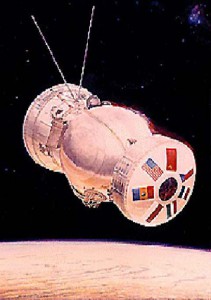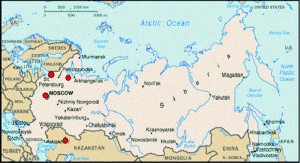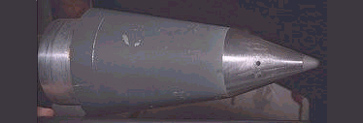By Michael Skidmore
To say that the Russian Space Program’s (RSA) approach to space flight is different than NASA’s is at best an understatement. I had the opportunity to experience some of this difference firsthand in late December 1996, while working with our Russian counterparts to prepare for the launch of Bion 11. This was the ninth mission in the COSMOS/Bion series and the first conducted under a bilateral NASA/RSA contract.
This mission was different from earlier ones in that it was our first joint mission, whereas on prior missions we flew as invited guests. This time we had control of 50 percent of the science payload. Earlier missions had covered a range of experimental models: everything from simple cell cultures to non-human primates. The purpose of this current mission was to study the physiological effects of flight on two 4- to 5-kg. male rhesus monkeys.
NASA’s role, in addition to specific scientific research goals, was to develop the bioinstrumentation and to work with our Russian counterparts to ensure that it was fully functional when integrated into the spacecraft. A striking indication that this was a different world from anything I’d experienced at NASA occurred when we got to the Plesetsk Cosmodrome in northern Russia where the launch took place.

The Bion program flew biological experiments using primates, rodents, insects, cells, and plants on an unmanned biosatellite in near-earth orbit.
It was December and the conditions in northern Russia during winter are obviously quite cold. Even so, this was an exceptional time. All of northern Europe was in the grip of a fierce winter storm, so the temperatures outside were especially harsh and the snow quite deep. On one occasion, while returning to the base late in the evening, the snow was falling so heavily we couldn’t see more than a few feet in front of the bus, and snowdrifts on the road were piled up as high as the hood. That the driver could see the road, could keep the bus on the road, and got us safely back to our quarters struck me as a small miracle.
What was also remarkable about this episode was that none of our Russian counterparts seemed to regard the bus ride as anything out of the ordinary. Understand correctly, in no way am I trying to suggest their attitudes were cavalier. What is “remarkable,” I think, is how their composure reflected the “get-the-job-done” culture of the Russian Space Program. Blizzards, sub-zero temperatures, hazardous road conditions, these were certainly obstacles to overcome, but did they ever weaken anyone’s resolve? You never heard so much as a complaint.
We saw this kind of stoic resolve throughout the project. One of the most impressive examples was when they had to deal with assembly and integration procedures to mount a top cover to one of their enclosures. The Russians found out they were short three screws so someone on their team found a box of parts, dumped them out, fished through them until they found three screws that fit, and we were back in business.
At NASA you can visualize a more “resource intensive” environment where the screws would arrive in certified containers with a specific screw for each position and mounds of paperwork verifying each part’s heritage back to the quarry.
Despite our cultural and work-related differences, we worked effectively with our Russian counterparts. Why? I would say the main reason was that together we approached the project as a unified team in the strongest sense of the word, meaning we shared the same goal of bringing off a successful mission. The two sub-teams were able to function as one united and effective team, overcoming the natural obstacles of an advanced technological endeavor. The key to this was collocation.
The bond and trust we established by working together, as well as suffering together, cannot be overstated. It was a tremendous improvement to be able to talk directly with them as a problem arose. For instance, on the night of the launch there appeared to be a technical glitch and we were called down to the launch facility from the hotel where we were staying. At first the Russians suspected it was an issue with our hardware. We could look at the equipment, discuss it with them, and we were able to establish categorically — to everyone’s satisfaction — that it was not our hardware.
Could we have achieved this as quickly and pleasantly as we did via distance? I will venture an opinion that our collocation under these austere conditions went a long way to warm their ears to what we said.
While we had some differences of opinion along the way, in part because there were fundamental differences in our approaches, overall the mission was a success. It was quite an education for me, working within the Russian system and seeing how differently they address and resolve problems. The take-away lesson for me was the realization that you can arrive at success in many different ways. The Russian procedures, while much less paper intensive and seemingly more accepting of risk than the U.S. methods, have been quite successful. The modified Soyuz rocket and Cosmos/Bion spacecraft have a success ratio in the range of 98%. While I wouldn’t go so far as to embrace their methods, there is certainly something we can learn from their experience and attitude that limited resources are a challenge, not a showstopper.
Lessons
- There is always more than one way to complete a project on time and on cost.
- Collocation helps to overcome cultural differences between individual members and provides the entire team with a unified sense of purpose.
Question
When is paperwork an indication of an orderly process, and when is it a reflection of mistrust?
Search by lesson to find more on:
- Teams








